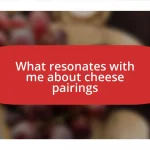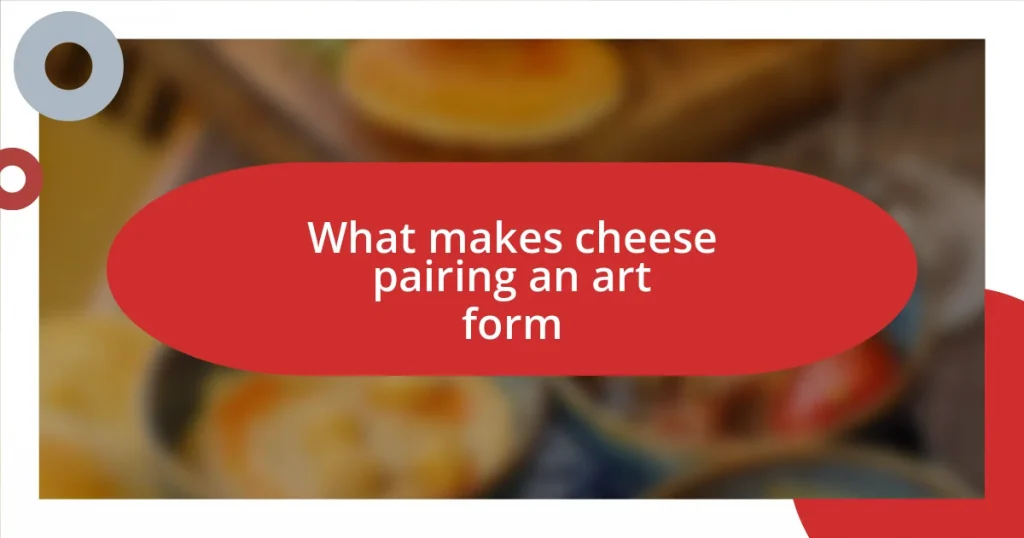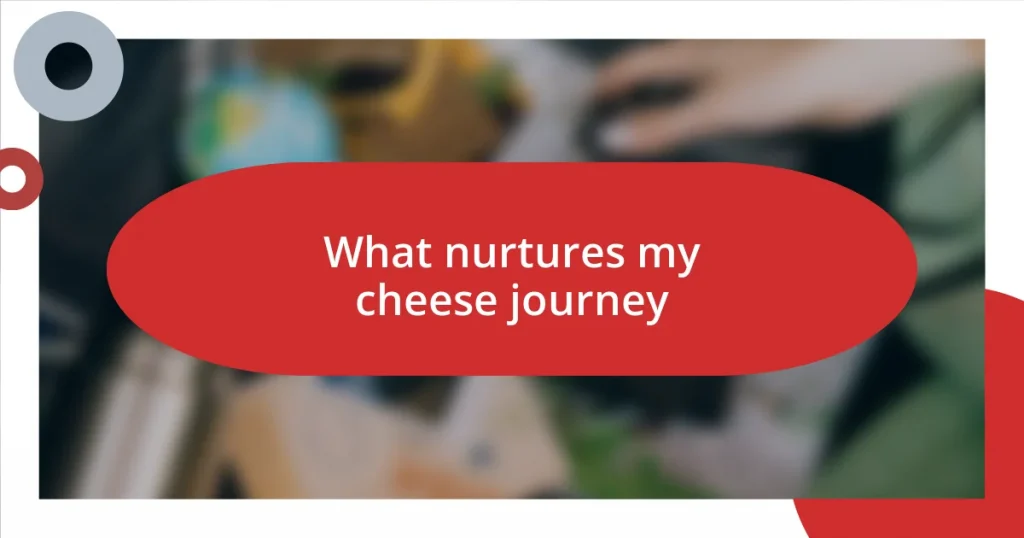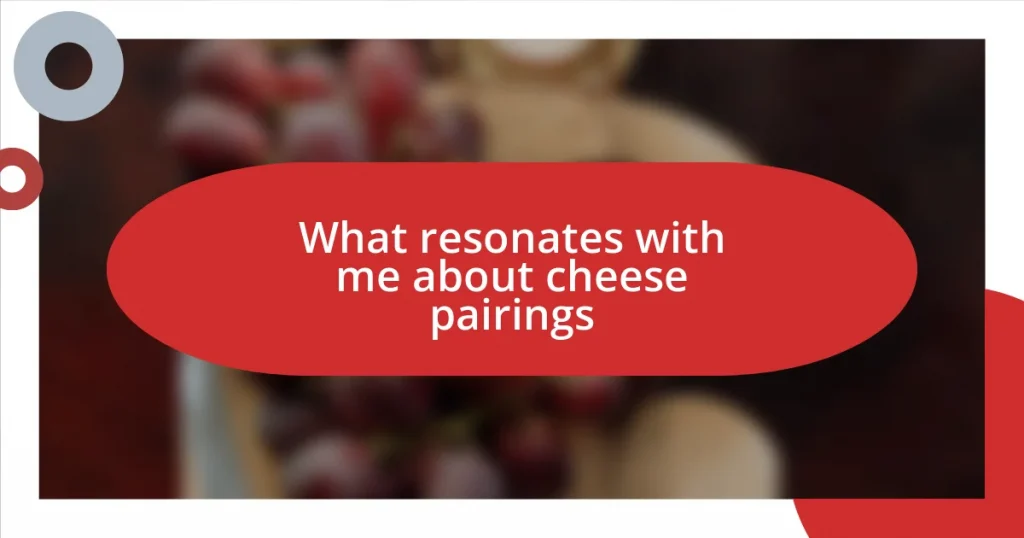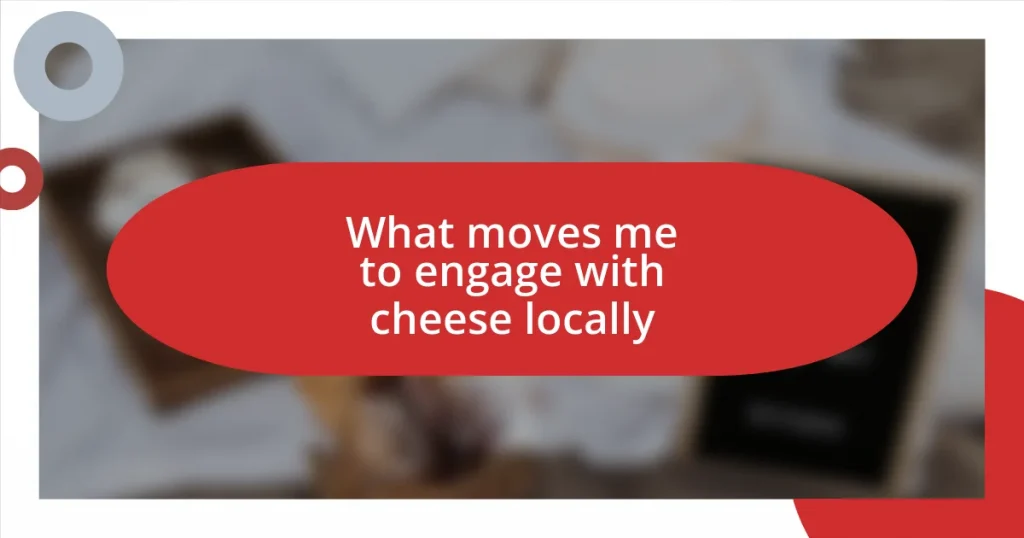Key takeaways:
- Cheese pairing is all about balancing textures and flavors, enhancing the overall tasting experience through contrasts and complements.
- Seasonal ingredients and complementary foods, such as fruits and crackers, can elevate the cheese experience significantly, creating memorable flavor combinations.
- The right wine can transform cheese pairings, with specific wine types enhancing distinct flavor profiles of different cheese varieties.
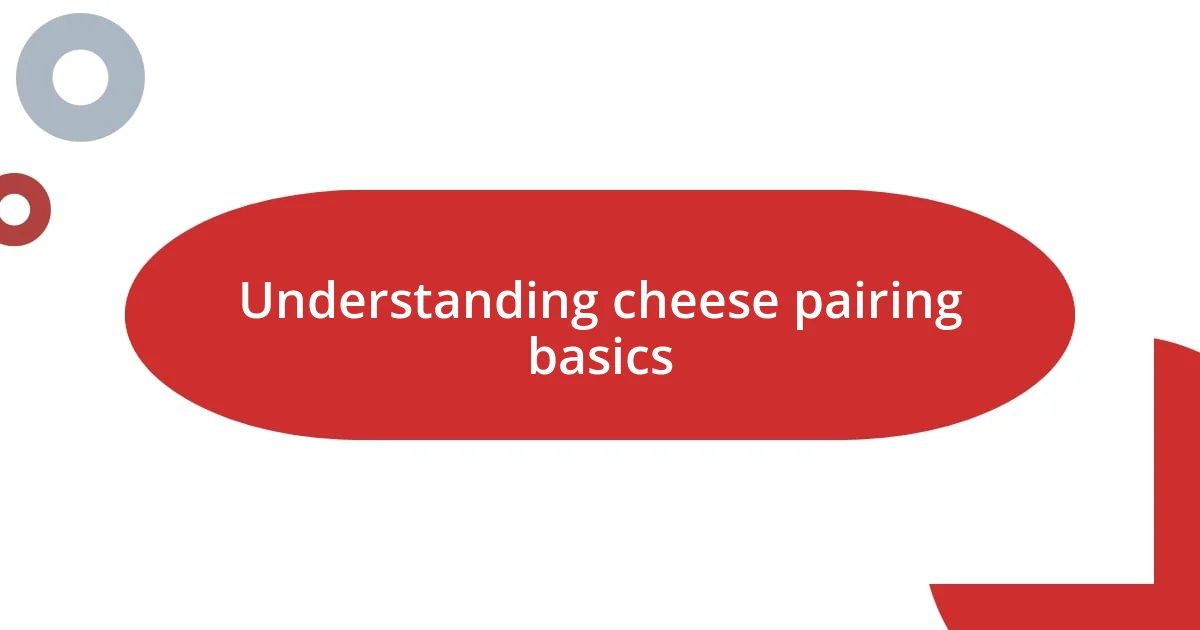
Understanding cheese pairing basics
When I first started exploring cheese pairing, I was amazed at how a simple slice of cheese could transform when paired with the right accompaniments. It’s about balance—think of how creamy brie can be elevated with a touch of tart fruit or how a sharp cheddar shines with rich, buttery crackers. Have you ever experienced a flavor explosion that caught you entirely off guard? That’s the magic of getting the basics right.
The fundamentals of cheese pairing generally revolve around contrasts and complements. This means finding a harmony between textures and flavors. For example, the creaminess of a triple-cream cheese can beautifully offset the crunch of a nutty cracker, creating a wonderful mouthfeel. I remember my first venture into this realm: pairing a tangy goat cheese with a drizzle of honey was a revelation! It was the perfect dance of flavors that felt almost like a celebration on my palate.
Another important aspect to consider is the intensity of flavors. Generally, stronger cheeses like blue cheese need bold accompaniments that can stand up to their powerful taste. Have you ever thought about how wine and cheese interact? The wrong pairing can muddle flavors, while the right one can elevate the entire experience. It’s this intricate dance of flavors that really defines the artistry of cheese pairing.
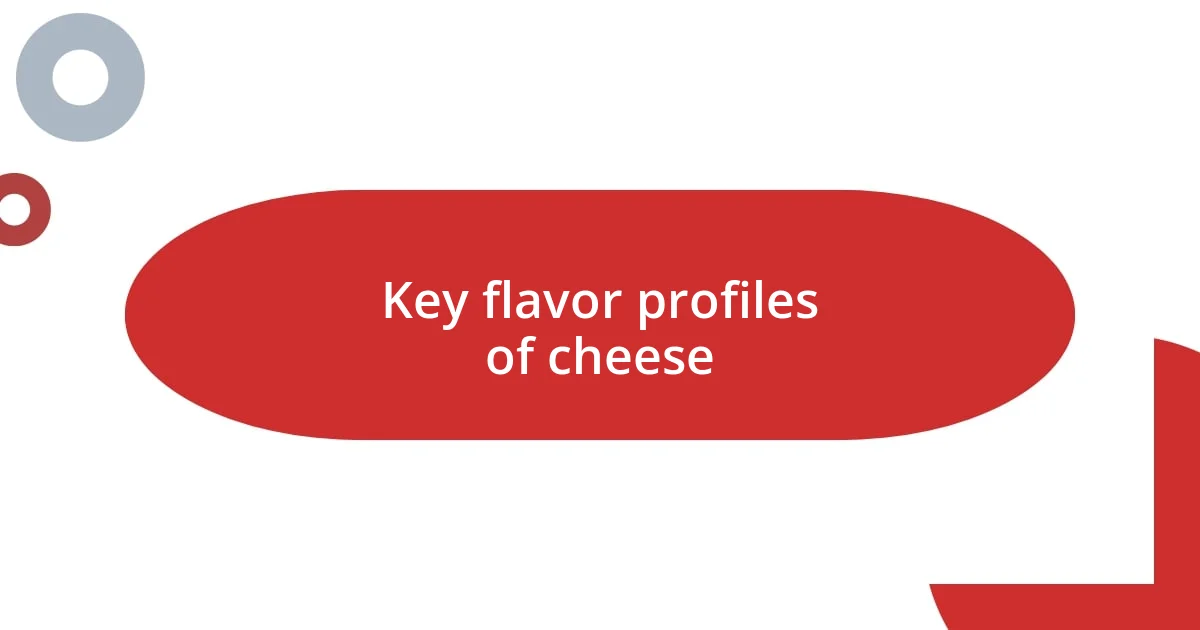
Key flavor profiles of cheese
Cheese consists of a remarkable array of flavor profiles, each with its unique characteristics. For instance, creamy cheeses like Camembert often exhibit buttery, mild flavors that can easily meld with sweet or tangy accompaniments. I remember first enjoying a slice of soft goat cheese topped with fig jam—a delightful combination that highlighted the cheese’s tanginess against the backdrop of the sweet, rich jam. It made me realize how essential it is to consider the flavor intensity of each component in the pairing.
Then there are aged cheeses, such as Parmigiano-Reggiano, known for their nutty and savory flavors. They often exhibit granular textures that pack a flavor punch, making them perfect for pairing with robust wines or dried fruits. I found that a simple pairing with a glass of Chianti brought out a depth in both elements that I had never anticipated. The wine’s acidity beautifully cut through the cheese’s richness, fostering an incredibly satisfying experience.
On the other hand, blue cheeses bring a whole different dimension to the table with their bold, pungent profiles that can sometimes be polarizing. Personally, I find that pairing blue cheese with something sweet—like a slice of pear or a drizzle of honey—creates a perfect balance. The sweetness tempers the sharpness, creating harmony on the palate. This revelation shifted my perspective on how contrasting flavors can truly elevate a cheese pairing experience.
| Cheese Type | Flavor Profile |
|---|---|
| Soft Cheese (e.g., Brie) | Creamy, Mild, Buttery |
| Aged Cheese (e.g., Parmigiano-Reggiano) | Nutty, Savory, Granular |
| Blue Cheese | Pungent, Bold, Sharp |

Complementary foods for cheese
Pairing cheese with complementary foods can truly elevate the tasting experience. I vividly recall enjoying a soft goat cheese with a delicate slice of smoked salmon. The creaminess of the cheese beautifully complemented the silky texture of the salmon, while the subtle smokiness enhanced the tartness of the cheese. It’s that kind of pairing that turns a simple appetizer into something memorable.
Consider these delicious pairings:
- Creamy brie with crusty baguette and fig jam
- Aged cheddar with apple slices and a drizzle of caramel
- Blue cheese with dark chocolate and fresh berries
- Sharp gouda with pickled vegetables and sweet mustard
- Ricotta with honey and candied nuts
Experiencing these combinations creates a tantalizing exploration of tastes. It reminds me of that delightful moment when flavors harmonize, igniting a new appreciation for cheese in my culinary journey. Each pairing tells its own story, reflecting the rich tapestry of flavors that cheese can offer when paired thoughtfully.
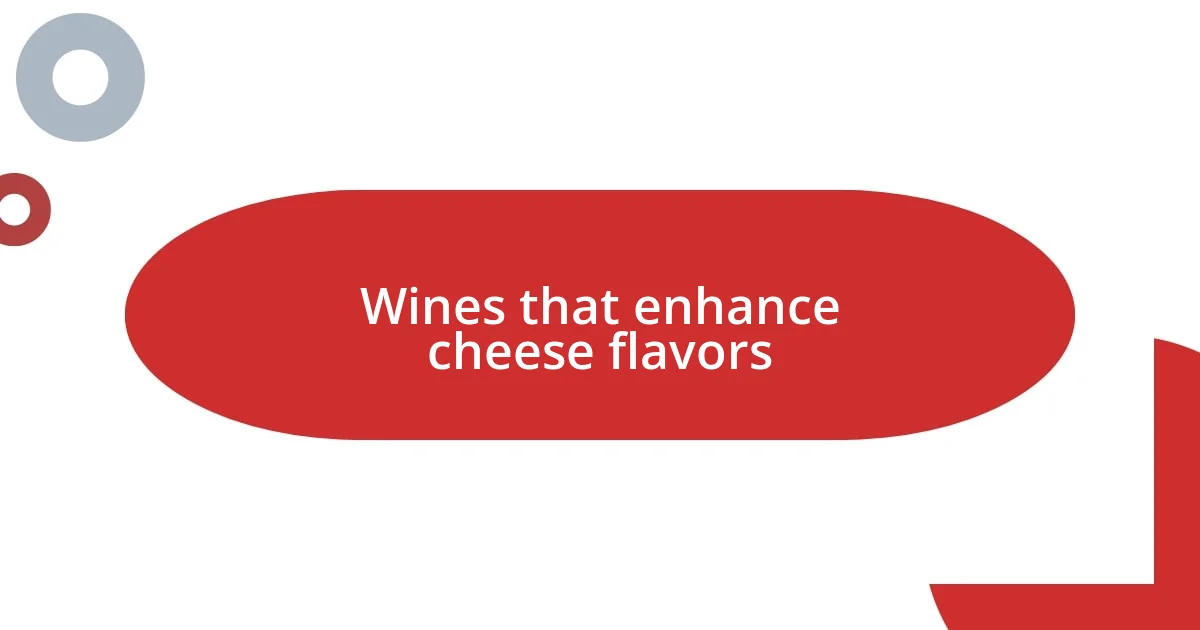
Wines that enhance cheese flavors
The world of wine and cheese pairing is truly fascinating, and I’ve found that the right wine can transform the flavor experience entirely. For example, I once savored a tangy goat cheese paired with a crisp Sauvignon Blanc. The wine’s citrus notes played wonderfully against the cheese’s earthiness, creating a refreshing contrast that left me wanting another bite. Isn’t it amazing how a sip of wine can enhance flavors we wouldn’t have anticipated?
I also discovered that rich, full-bodied red wines like Cabernet Sauvignon can elevate aged cheeses, such as Gouda or Gruyère, to another realm. I remember indulging in a bold Cabernet alongside a slice of aged Gouda; the wine’s tannins cut through the cheese’s creaminess, making each taste more robust and satisfying. It was one of those “aha” moments that made me appreciate the deep connection between these two culinary delights.
Light-bodied wines, like a dry Riesling, can work wonders with soft, creamy cheeses as well. I experimented by pairing a soft Brie with Riesling, and the wine’s slight sweetness danced perfectly with the cheese’s buttery texture. This combination made me reflect on how enhancing flavors can come from unexpected sources, inviting us to explore further and deeper into the realm of cheese and wine pairing. Isn’t it exciting to think about what you might discover in your own taste journey?
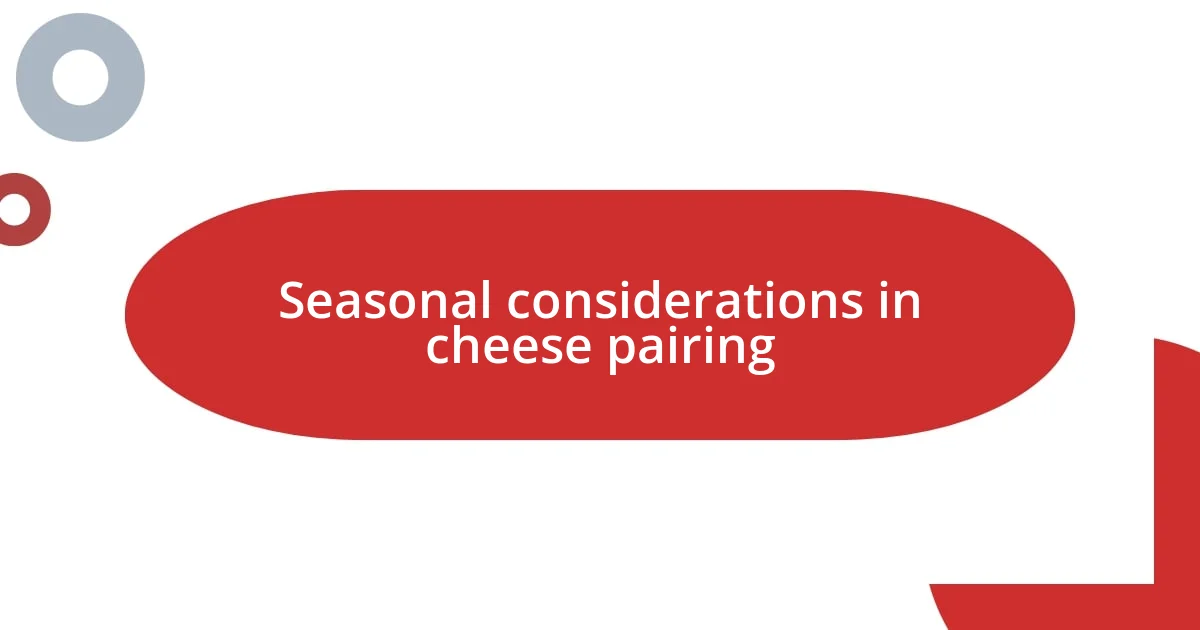
Seasonal considerations in cheese pairing
As the seasons change, so too do the ideal cheese pairings. I remember one fall day, I crafted a platter of nutty Gruyère alongside roasted butternut squash. The sweet, caramelized flavors of the squash complemented the cheese’s richness marvelously. Have you ever tried combining seasonal produce with cheese? It’s a delightful way to embrace the flavors of the moment.
In summer, I gravitate towards lighter, fresher cheeses, often pairing them with fruits that are in peak season. One sunny afternoon, I enjoyed fresh mozzarella drizzled with olive oil and sprinkled with garden tomatoes. The creamy texture of the cheese, combined with the sweetness of the tomatoes, created a refreshing bite that encapsulated the warmth of the season. I find that pairing cheeses with seasonal fruits and veggies can elevate the experience and create a sense of harmony with nature.
Winter calls for more robust flavors, and I particularly enjoy combining strong cheeses like aged Gouda with hearty accompaniments. Just last December, I created a cozy cheese board featuring the Gouda alongside spiced nuts and dried figs. The rich, caramel notes of the cheese interplayed beautifully with the spices, evoking the warmth of the season. How does the shift in temperature influence your culinary choices? For me, seasonal considerations not only guide what I choose to pair but also enrich my connection to each bite.
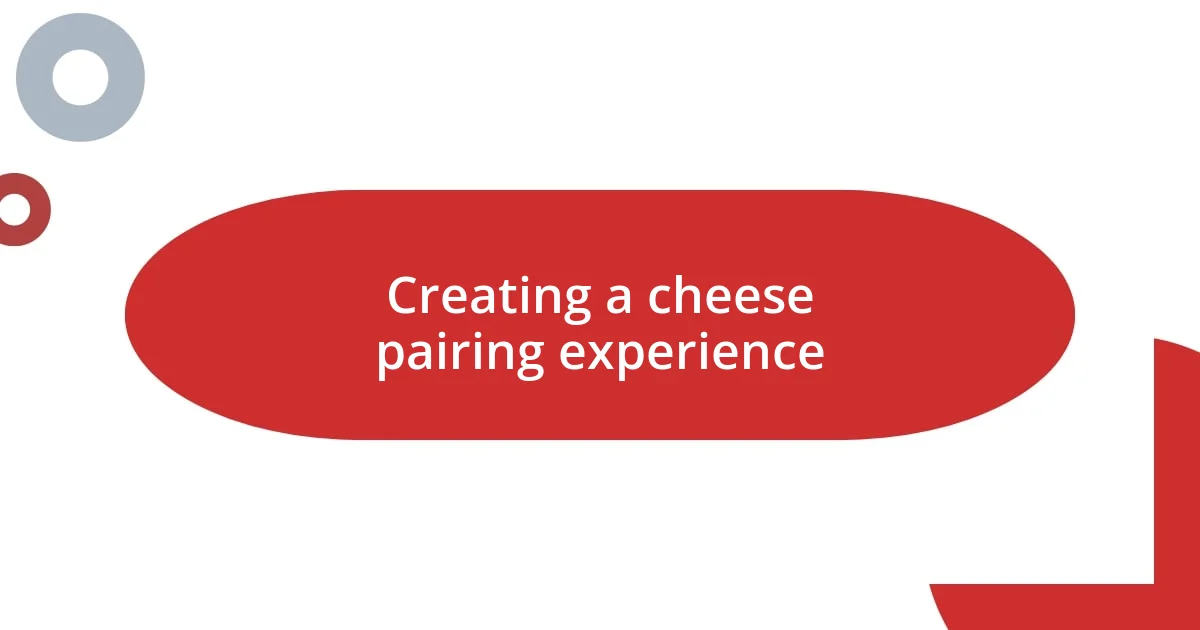
Creating a cheese pairing experience
Creating a memorable cheese pairing experience involves more than simply selecting cheeses and accompaniments; it’s about crafting a journey for the taste buds. I recall one gathering where I curated a cheese flight that included a sharp cheddar, a creamy Camembert, and a tangy blue cheese. With each cheese served alongside unique jams and crackers, I noticed how guests would explore the flavors, creating a lively conversation that sparked excitement and curiosity.
Presentation plays a pivotal role in enhancing the experience as well. I once set up a rustic wooden board at a celebration, adorned with fresh herbs, colorful fruits, and artisanal crackers all accentuating the vibrant cheeses. Watching my friends interact, each strategically pairing flavors while sharing their thoughts and discoveries, filled me with joy. It was fascinating to see how an inviting display transformed casual tasting into a full-fledged event, igniting engagement and conversation.
In my experience, the right ambiance can elevate a cheese pairing session beyond mere tasting. I remember hosting a cozy evening by candlelight, with a carefully curated playlist in the background that set the mood. The warm lights, intimate setting, and aromatic cheeses combined into an experience that felt both luxurious and accessible. How do you envision pairing moments transforming your gatherings? I believe that by intertwining atmosphere and flavor, we elevate cheese pairing from a simple activity into a cherished memory.

